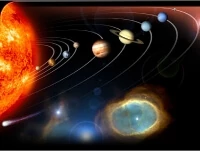
To understand what transits are in astrology, you must first understand what aspects are. You should already know that aspects are relationships, measured in degrees of arc, between two planets in your birth chart. (An aspect can also take place between a planet and a special angle or point in your birth chart, i.e. Ascendant, M.C., I.C., Descendant, Lunar Nodes, and some other points.)
Transits are, in effect, aspects between a planet’s current position up above and its position in your birth chart.
The positions of the planets at the moment you were born are captured on your birth chart. As you took your first breath, the planets continued on their tracks. As the planets continue moving, every once in a while, they come into aspect with the planetary positions on your birth chart.
For example, say you were born with the Sun at 16 ° and 28 minutes of Cancer, and Pluto at 24 ° of Libra. When Pluto moved into 16 degrees of Capricorn, in the year 2016, it made an opposition aspect (180 °) to your natal Sun.
To be clear, that aspect is called a “transit.” We would not call it an aspect because when we speak of aspects, we are usually speaking of natal aspects based on the positions of the planets at someone’s birth. An aspect made by a transiting planet is called a “transit” in astrology.
A moving planet can stay in aspect anywhere from a few hours up to a few years. The moon, because she moves so fast, makes aspects only for a short hour or two. And then she’s gone. Neptune and Pluto, because they move so slowly (relative motion), can stay in aspect for 2 or 3 years. Use an orb of 1 degree to consider transits (but use a 2 degree orb to plan ahead!) While a moving planet is in aspect to a natal planetary position, the moving planet is said to be “transiting” the natal planet.
The transit has an influence over you during the entire time that it’s transiting, but it also has a point at which it becomes “exact.” This is the day when it reaches the exact degree, minute, and second of your birth planet. Some transits can become exact three times because of retrograde motion: the transiting planet passes over the point once, then the planet goes retrograde and backtracks over the point, then the planet goes back into direct motion and passes over the point a third time.
In the example above, Pluto would be transiting your natal Sun throughout most of 2016 because it will be close enough to 16 ° to be considered in aspect. But that transit becomes “exact” in 2016 when Pluto reaches exactly 10 ° and 28 minutes of Capricorn.
In summary, transits are simply aspects made by the current moving planets to our birth-chart planets. Technically, the planets are always in transit, as in “on the move.” But in astrology, “transit” is a term of art. In the language of astrology, planets make “transits” or are “transiting” only when they make aspects to our birth chart.
To find out your own personal transits, try the Transits calculator.
 ⌕
⌕